词汇学论文构词法[1]
- 格式:doc
- 大小:60.50 KB
- 文档页数:7
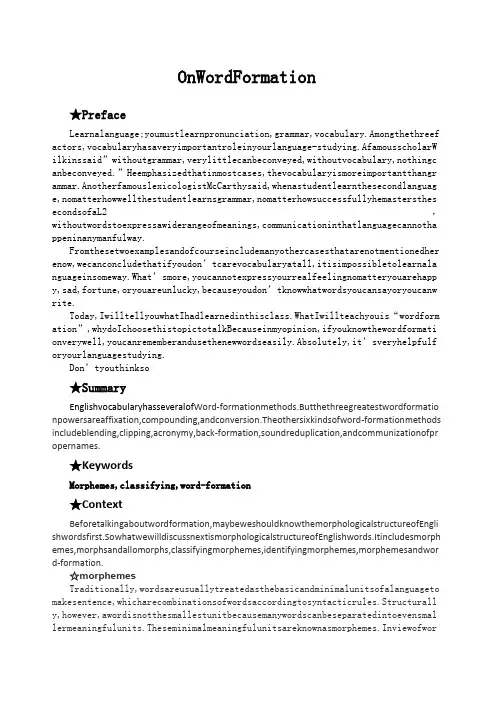
OnWordFormation★PrefaceLearnalanguage;youmustlearnpronunciation,grammar,vocabulary.Amongthethreef actors,vocabularyhasaveryimportantroleinyourlanguage-studying.AfamousscholarW ilkinssaid”withoutgrammar,verylittlecanbeconveyed,withoutvocabulary,nothingc anbeconveyed.”H eemphasizedthatinmostcases,thevocabularyismoreimportantthangr ammar.AnotherfamouslexicologistMcCarthysaid,whenastudentlearnthesecondlanguag e,nomatterhowwellthestudentlearnsgrammar,nomatterhowsuccessfullyhemastersthes econdsofaL2,withoutwordstoexpressawiderangeofmeanings,communicationinthatlanguagecannotha ppeninanymanfulway.Fromthesetwoexamplesandofcourseincludemanyothercasesthatarenotmentionedher enow,wecanconcludethatifyoudon’tcarevocabularyatall,itisimpossibletolearnala nguageinsomeway.What’smore,youcannotexpressyourrealfeelingnomatteryouarehapp y,sad,fortune,oryouareunlucky,becauseyoudon’tknowwhatwordsyoucansayoryoucanw rite.Today,IwilltellyouwhatIhadlearnedinthisclass.WhatIwillteachyouis“wordform ation”,whydoIchoosethistopictotalkBecauseinmyopinion,ifyouknowthewordformati onverywell,youcanrememberandusethenewwordseasily.Absolutely,it’sveryhelpfulf oryourlanguagestudying.D on’t youthinkso★SummaryEnglishvocabularyhasseveralof Word-formationmethods.Butthethreegreatestwordformatio npowersareaffixation,compounding,andconversion.Theothersixkindsofword-formationmethods includeblending,clipping,acronymy,back-formation,soundreduplication,andcommunizationofpr opernames.★KeywordsMorphemes,classifying,word-formation★ContextBeforetalkingaboutwordformation,maybeweshouldknowthemorphologicalstructureofEngli shwordsfirst.SowhatwewilldiscussnextismorphologicalstructureofEnglishwords.Itincludesmorph emes,morphsandallomorphs,classifyingmorphemes,identifyingmorphemes,morphemesandwor d-formation.☆morphemesTraditionally,wordsareusuallytreatedasthebasicandminimalunitsofalanguageto makesentence,whicharecombinationsofwordsaccordingtosyntacticrules.Structurall y,however,awordisnotthesmallestunitbecausemanywordscanbeseparatedintoevensmal lermeaningfulunits.Theseminimalmeaningfulunitsareknownasmorphemes.Inviewofword-formation,themorphemeisseenas‘thesmallestfunctioningunitinthecompositionof words’.Syn tactically,however,amorphemeistheminimalformofgrammaticalanalysis.Morphemesareabstractunits,whicharerealizedinspeechbydiscreteunitsknownasmo rphs.Theyareactualspoken,minimalcarriersofmeaning.Morphemesvaryinfunction.Accordingly,wecanclassifymorphemesintoseveralgener alcategories:①FreeversusBoundMorphemes----morphemeswhichareindependentofothermorphemes arefree.Thesemorphemeshavecompletemeaningsinthemselvesandcanbeusedasfreegramm aticalunitsinsentences.Morphemeswhichcannotoccurasseparatewordsarebound.Theya resonamedbecausetheyareboundtoothermorphemestoformwordsortoperformaparticular grammaticalfunction.②DerivationalversusInflectionalMorphemes----morphemeswhichareusedtoderive newwordsareknownasderivationalmorphemesbecausewhenthesemorphemesareconjoined, newwordsarederived.③ContentversusGrammaticalMorphemes----Onasemanticandsyntacticbasis,morphe mescanfallintocontentandgrammaticalmorphemes.Contentmorphemesarelexicalmorphe meswhichareusedasweseeabovetoderivenewwords,soalsoknownasderivationalmorpheme s.☆MorphemesandWord-formationWeknowthatwordscanbeanalyzedintomorphemes,whicharetheminimalmeaningfulunit sinthecompositionofwords.Inword-formationformation,however,morphemesareconven tionallylabeledroot,stem,baseandaffix.Affixesareformsthatareattachedtowordsorelementstomodifymeaningorfunction.A ffixesareboundmorphemesbecausenoneofthemcanstandaswordsintheirownright.Accord ingtothefunctionsofaffixes,wecandividethemintoinflectionalaffixesandderivatio nalaffixes.Derivationalandinflectionalaffixesareidenticalwithderivationalandi nflectionalmorphemes.Inviewoftheirdistributionintheformationofword,affixescan fallintoprefixandsuffix.Beforewebeginouractualdiscussionofword-buildingprocesses,therearesomebasic conceptsthatneedclarifying:1.Root:arootisthebasicformofawordwhichcannotbefurtheranalyzedwithouttotallossofidentity.2.Stem:astemmayconsistofasinglerootmorphemeoroftworootmorphemes.Itcanbearootmorphemeplusoneormoreaffixationalmorphemes.3.Base:abaseisreferredtoaformtowhichaffixesofanykindcanbeadded.Itcanbearootorastem.☆ WordFormationTheexpansionofvocabularyinmodernEnglishdependschieflyonwordformation.There isavarietyofmeansbeingatworknow.Themostproductiveareaffixation,compoundingand conversion.⑴AffixationAffixationisgenerallydefinedastheformationofwordsbyaddingword-formingorder ivationalaffixestobase.Thisprocessisalsoknownasderivation,bywhichnewwordsared erivedfromoldorbaseforms.Thewordscreatedinthiswayarecalledderivatives.Accordi ngtothepositionsaffixesoccupyinwords,affixationfallsintotwosubcategories:prefixationandsuffixation.Prefixation includes:NegativePrefixes(a-,dis-,in-,non-,un-…)ReversativeorPrivativePrefixes(de-,dis-,un,…)PejorativePrefixes(mal-,mis-,pseudo-…)PrefixesofDegreeorSize(arch-,co-,extra-,hyper-,macro-,micro-,mini-,out-,over-,sub-,super-,sur-,ultra-,under-…) PrefixesofOrientationandAttitude(anti-,contra-,counter-,pro-…)LocativePrefixes(fore-,inter-,intra-,super-,tele-,trans-…)PrefixesofTimeandOrder(ex-,fore-,post-,pre-,re-…)NumberPrefixes(bi-,multi-,semi-,tri-,uni-…)ConversionPrefixes(a-,be-,en-…)MiscellaneousPrefixes(auto-,neo-,pan-,proto-,vice-…)Suffixation includes:Nounsuffixes(denominalnouns,deverbalnouns,de-adjectivenouns,nonandadjecti vesuffixes)Adjectivesuffixes(denominalsuffixes,deverbalsuffixes)Adverbsuffixes(Omitexample)Verbsuffixes(Omitexample)⑵CompoundingCompoundingistheformationofnewwordsbyjoiningtwoormorebases.Wordsworthforme poundscanbewrittensolid,hyphenatedandopen.1.CharacteristicsofcompoundsCompoundshavenoticeablecharacteristicswhichmayinmostcasesdifferentiatethem selvesfromnounphrasesinthefollowingfouraspects:Phonologicalfeatures,semanticfeatures,grammatical,orthographicalfeatures.2.FormationofcompoundsCompoundingcantakeplacewithinanyofthewordclass,buttheproductiveonesarenoun sandadjectivesfollowedbyverbstoamuchlesserextent.Nouncompounds,adjectivecompounds,verbcompounds.⑶ConversionConversionistheformationofnewwordsbyconvertingwordsofoneclasstoanotherclas s.Conversionisgenerallyconsideredtobeaderivationalprocesswherebyanitemisadapt edorconvertedtoanewwordclasswithouttheadditionofanaffix.Hencethenamezero-deri vation.Wordsproducedbyconversionareprimarilynouns,adjectives,andverbs.Conversiontonouns(deverbal,de-adjectival,miscellaneousconversion)Conversiontoverbs(denominal,de-adjectival,miscellaneousconversion)conversiontoadjectives(voicelesstovoicedconsonant,initialtoendstress) theothersixmeansofword-formationincludes:Blending,Clipping,Acronymy,Back-formation,Soundreduplication,Communizationofp ropernames.Becausethewordslimit,thesixword-formationmethodsisnotdetailedintroducedher e.Ifyouareinterestedinthem,pleaserefertothelexicology.Annotation:《英语词汇学教程》张伟友着,《词汇学学习指南》杨春慧着。
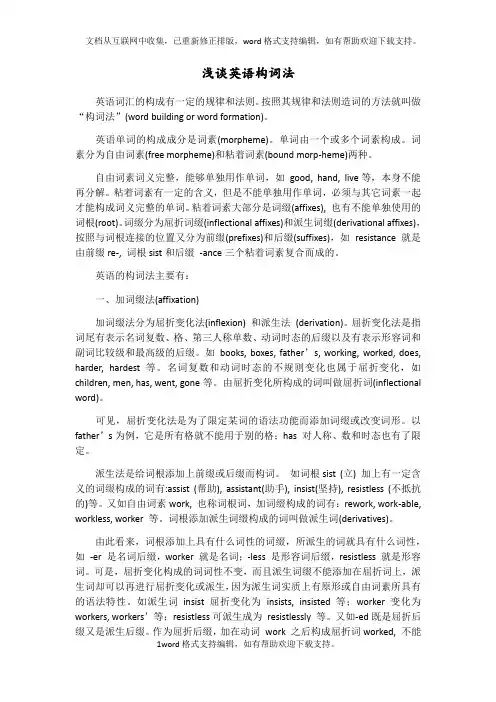
浅谈英语构词法英语词汇的构成有一定的规律和法则。
按照其规律和法则造词的方法就叫做“构词法”(word building or word formation)。
英语单词的构成成分是词素(morpheme)。
单词由一个或多个词素构成。
词素分为自由词素(free morpheme)和粘着词素(bound morp-heme)两种。
自由词素词义完整,能够单独用作单词,如good, hand, live等,本身不能再分解。
粘着词素有一定的含义,但是不能单独用作单词,必须与其它词素一起才能构成词义完整的单词。
粘着词素大部分是词缀(affixes), 也有不能单独使用的词根(root)。
词缀分为屈折词缀(inflectional affixes)和派生词缀(derivational affixes),按照与词根连接的位置又分为前缀(prefixes)和后缀(suffixes),如resistance就是由前缀re-, 词根sist和后缀-ance三个粘着词素复合而成的。
英语的构词法主要有:一、加词缀法(affixation)加词缀法分为屈折变化法(inflexion) 和派生法(derivation)。
屈折变化法是指词尾有表示名词复数、格、第三人称单数、动词时态的后缀以及有表示形容词和副词比较级和最高级的后缀。
如books, boxes, father’s, working, worked, does, harder, hardest等。
名词复数和动词时态的不规则变化也属于屈折变化,如children, men, has, went, gone等。
由屈折变化所构成的词叫做屈折词(inflectional word)。
可见,屈折变化法是为了限定某词的语法功能而添加词缀或改变词形。
以father’s为例,它是所有格就不能用于别的格;has 对人称、数和时态也有了限定。
派生法是给词根添加上前缀或后缀而构词。
如词根sist (立) 加上有一定含义的词缀构成的词有:assist (帮助), assistant(助手), insist(坚持), resistless (不抵抗的)等。

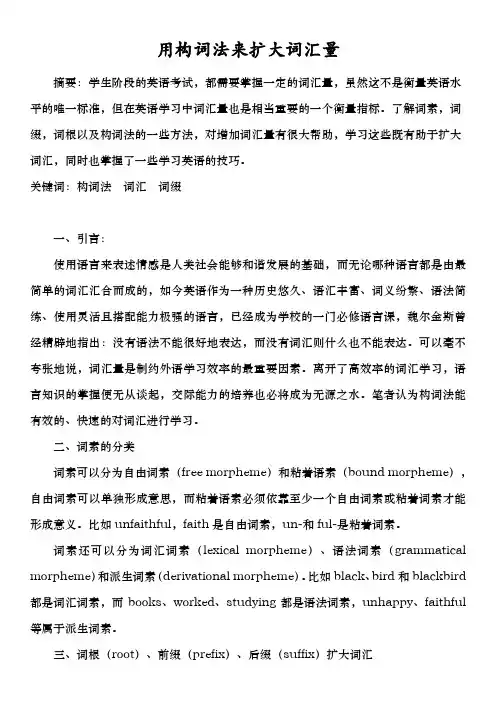
用构词法来扩大词汇量摘要:学生阶段的英语考试,都需要掌握一定的词汇量,虽然这不是衡量英语水平的唯一标准,但在英语学习中词汇量也是相当重要的一个衡量指标。
了解词素,词缀,词根以及构词法的一些方法,对增加词汇量有很大帮助,学习这些既有助于扩大词汇,同时也掌握了一些学习英语的技巧。
关键词:构词法词汇词缀一、引言:使用语言来表述情感是人类社会能够和谐发展的基础,而无论哪种语言都是由最简单的词汇汇合而成的,如今英语作为一种历史悠久、语汇丰富、词义纷繁、语法简练、使用灵活且搭配能力极强的语言,已经成为学校的一门必修语言课,魏尔金斯曾经精辟地指出:没有语法不能很好地表达,而没有词汇则什么也不能表达。
可以毫不夸张地说,词汇量是制约外语学习效率的最重要因素。
离开了高效率的词汇学习,语言知识的掌握便无从谈起,交际能力的培养也必将成为无源之水。
笔者认为构词法能有效的、快速的对词汇进行学习。
二、词素的分类词素可以分为自由词素(free morpheme)和粘着语素(bound morpheme),自由词素可以单独形成意思,而粘着语素必须依靠至少一个自由词素或粘着词素才能形成意义。
比如unfaithful,faith是自由词素,un-和ful-是粘着词素。
词素还可以分为词汇词素(lexical morpheme)、语法词素(grammatical morpheme)和派生词素(derivational morpheme)。
比如black、bird和blackbird 都是词汇词素,而books、worked、studying都是语法词素,unhappy、faithful 等属于派生词素。
三、词根(root)、前缀(prefix)、后缀(suffix)扩大词汇(1)词根词根是一个单词的基础,用来表达最本质的意思。
同样词根也可以分为自由词根(free root)和粘着词根(bound root)。
比如:teacher中的teach、worker中的work是自由词素,antiquity中的antiq(表古老),accelerate中的celer(表示快,迅速)是词根词素。

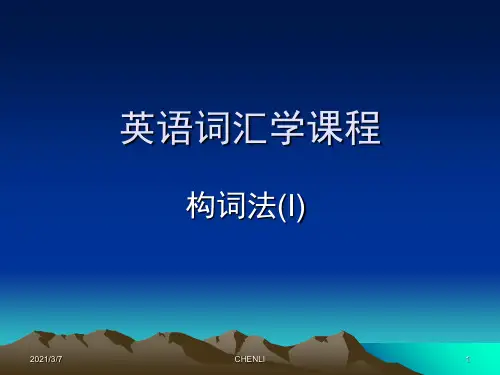

论文英语三大主要构词法
1. 以希腊和拉丁词根为主的构词法:这种构词法是指借助希腊或拉丁的字根、词缀、前缀、后缀等方式形成新词语或变换词性的词法。
比如,biology(生物学)由希腊词根 bios(生命)和logy(科学)构成,而prefix(前缀)由拉丁词根pre(前)和 fixus(固定的)构成。
2. 以非原型词为主的构词法:这种构词法是指通过对已有的单词进行改变、缩写、组合或转化等方式来创造新的词语。
比如,email(电子邮件)是由电子(electronic)和邮件(mail)两个词合并而成的。
3. 以简单词语为主的构词法:这种构词法是指直接使用简单的基本单词来构建新的复合词、派生词,或者将它们组织在一起,构成一定意义或表达特定含义的短语。
比如,bookstore(书店)是由book(书)和store(商店)组合而成的。
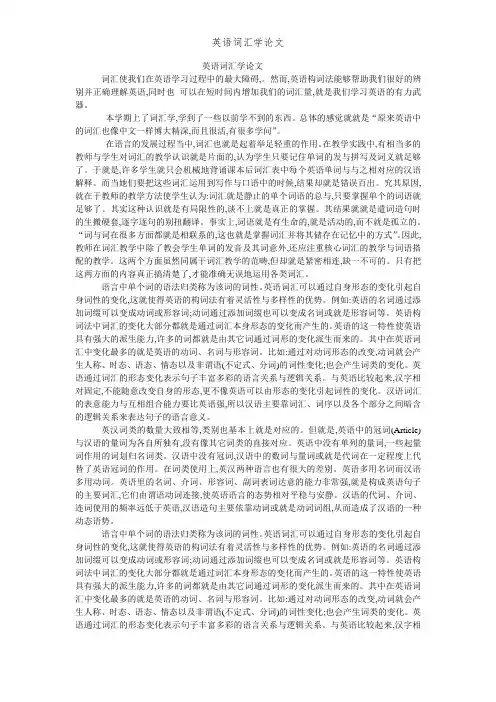
英语词汇学论文词汇使我们在英语学习过程中的最大障碍,。
然而,英语构词法能够帮助我们很好的辨别并正确理解英语,同时也可以在短时间内增加我们的词汇量,就是我们学习英语的有力武器。
本学期上了词汇学,学到了一些以前学不到的东西。
总体的感觉就就是“原来英语中的词汇也像中文一样博大精深,而且很活,有很多学问”。
在语言的发展过程当中,词汇也就是起着举足轻重的作用。
在教学实践中,有相当多的教师与学生对词汇的教学认识就是片面的,认为学生只要记住单词的发与拼写及词义就足够了。
于就是,许多学生就只会机械地背诵课本后词汇表中每个英语单词与与之相对应的汉语解释。
而当她们要把这些词汇运用到写作与口语中的时候,结果却就是错误百出。
究其原因,就在于教师的教学方法使学生认为:词汇就是静止的单个词语的总与,只要掌握单个的词语就足够了。
其实这种认识就是有局限性的,谈不上就是真正的掌握。
其结果就就是遣词造句时的生搬硬套,逐字逐句的别扭翻译。
事实上,词语就是有生命的,就是活动的,而不就是孤立的。
“词与词在很多方面都就是相联系的,这也就是掌握词汇并将其储存在记忆中的方式”。
因此, 教师在词汇教学中除了教会学生单词的发音及其词意外,还应注重核心词汇的教学与词语搭配的教学。
这两个方面虽然同属于词汇教学的范畴,但却就是紧密相连,缺一不可的。
只有把这两方面的内容真正搞清楚了,才能准确无误地运用各类词汇。
语言中单个词的语法归类称为该词的词性。
英语词汇可以通过自身形态的变化引起自身词性的变化,这就使得英语的构词法有着灵活性与多样性的优势。
例如:英语的名词通过添加词缀可以变成动词或形容词;动词通过添加词缀也可以变成名词或就是形容词等。
英语构词法中词汇的变化大部分都就是通过词汇本身形态的变化而产生的。
英语的这一特性使英语具有强大的派生能力,许多的词都就是由其它词通过词形的变化派生而来的。
其中在英语词汇中变化最多的就是英语的动词、名词与形容词。
比如:通过对动词形态的改变,动词就会产生人称、时态、语态、情态以及非谓语(不定式、分词)的词性变化;也会产生词类的变化。
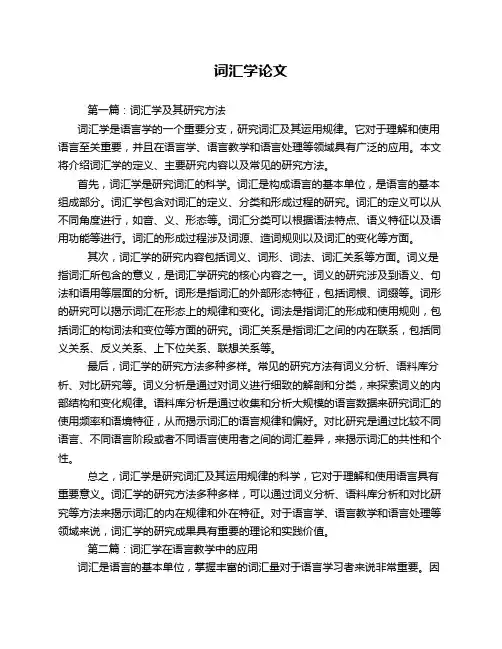
词汇学论文第一篇:词汇学及其研究方法词汇学是语言学的一个重要分支,研究词汇及其运用规律。
它对于理解和使用语言至关重要,并且在语言学、语言教学和语言处理等领域具有广泛的应用。
本文将介绍词汇学的定义、主要研究内容以及常见的研究方法。
首先,词汇学是研究词汇的科学。
词汇是构成语言的基本单位,是语言的基本组成部分。
词汇学包含对词汇的定义、分类和形成过程的研究。
词汇的定义可以从不同角度进行,如音、义、形态等。
词汇分类可以根据语法特点、语义特征以及语用功能等进行。
词汇的形成过程涉及词源、造词规则以及词汇的变化等方面。
其次,词汇学的研究内容包括词义、词形、词法、词汇关系等方面。
词义是指词汇所包含的意义,是词汇学研究的核心内容之一。
词义的研究涉及到语义、句法和语用等层面的分析。
词形是指词汇的外部形态特征,包括词根、词缀等。
词形的研究可以揭示词汇在形态上的规律和变化。
词法是指词汇的形成和使用规则,包括词汇的构词法和变位等方面的研究。
词汇关系是指词汇之间的内在联系,包括同义关系、反义关系、上下位关系、联想关系等。
最后,词汇学的研究方法多种多样。
常见的研究方法有词义分析、语料库分析、对比研究等。
词义分析是通过对词义进行细致的解剖和分类,来探索词义的内部结构和变化规律。
语料库分析是通过收集和分析大规模的语言数据来研究词汇的使用频率和语境特征,从而揭示词汇的语言规律和偏好。
对比研究是通过比较不同语言、不同语言阶段或者不同语言使用者之间的词汇差异,来揭示词汇的共性和个性。
总之,词汇学是研究词汇及其运用规律的科学,它对于理解和使用语言具有重要意义。
词汇学的研究方法多种多样,可以通过词义分析、语料库分析和对比研究等方法来揭示词汇的内在规律和外在特征。
对于语言学、语言教学和语言处理等领域来说,词汇学的研究成果具有重要的理论和实践价值。
第二篇:词汇学在语言教学中的应用词汇是语言的基本单位,掌握丰富的词汇量对于语言学习者来说非常重要。

词汇学论文对英语构词法的一点认识英语116班说实话,整本英语词汇学教程学下来,留在我脑子中的东西并不多,但惟独对第四章构词法(word formation)印象很深。
这一章一共介绍了9种构词法,分别是:词缀法(affixation)、组合法(compounding)、转换法(conversion)、混合法(blending)、缩略词法(clipping)、首字母缩写法(acronymy)、逆构法(back-formation)、声音重复法(sound reduplication)以及专有名词的泛化(commonization of proper names)。
今天我在这里想谈谈主要的4种构词法:词缀法(affixation)、合成法(compounding)、转换法(conversion)、混合法(blending)以及对它们的一些认识。
(一)词缀法(affixation)在所有的英语构词法中,词缀法能够生成的新单词是最多的也是最广泛,它被认为英语学习的最佳途径之一。
1.前缀法(prefixation):在词根前加前缀,多数情况下词类不变。
主要有一下几种情况:表否定意思的前缀、表示相反的或者剥夺性质的前缀、表示变坏的前缀、表示范围和程度的前缀、表示方向和态度的前缀、表示方位的前缀、表示时间和顺序的前缀、表示数字的前缀、转化前缀以及其他类型的前缀。
2.后缀法(suffixation):在词根后面加后缀,多数情况下词类改变。
后缀主要有名词后缀、形容词后缀、副词后缀和动词后缀。
3.中缀法(infixation):很少见,加中缀通常表明演讲者的态度,并且不会改变单词的词性和意思。
事实上,在词汇学的书里也没有提到中缀,我也只是在语言学的课上知道还有中缀这么一种词缀。
(二)合成法(compounding)合成也许是最常见的扩大英语词汇量的方式,它允许使用者将两个或两个以上熟悉的词组合在一起形成一个新的词,产生新的语义。
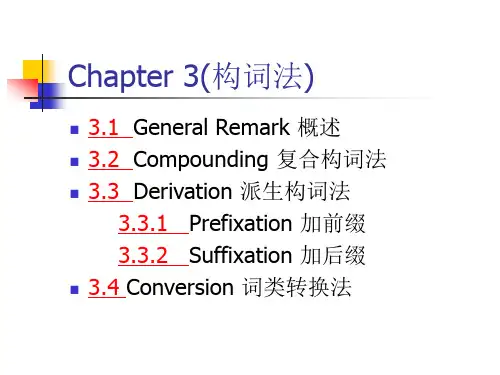
在新课标下如何教好学生学习词汇【摘要】本文主要研究英语词汇教学在英语教学中的重要性。
在新课标下,挖掘学生学习词汇的兴奋点,提高词汇学习的效率。
通过用生动形象教学语言来激发学习兴趣。
强化语音教学,为词汇教学打好基础。
利用英语构词法进行词汇教学来扩大学生的词汇量。
运用语境教学提高教学效果。
教给学生一些词汇记忆策略,结合各种词汇教学活动进一步提高词汇教学的有效性。
【关键词】词汇教学语境教学词汇记忆词汇是语言的三大要素之一,是语言的素材。
要掌握一门外语,就必须掌握大量的外语单词。
在英语教学中,词汇教学是英语教学的基础环节;对学生来说,正确掌握和运用词汇,是为进一步学习语言的基础和提高听说读写能力的前提和保障。
作为一个英语教学工作者,如何有效地进行英语词汇教学,将直接影响到学生是否真正理解和掌握英语,能否切实有效地运用英语进行交际。
一、英语词汇教学的意义英语教学离不开词汇教学,词汇教学是英语教学中的重要环节,掌握一定量的词汇是学好英语的基础。
词汇学习惯穿于语言学习的全过程,不掌握一定量的词汇,阅读,听说,书写都无法顺利进行。
因而就直接影响学生学习英语的兴趣和英语能力的运用和发展。
”词汇教学不只是让学生学习单词的音、义其主要目的是使学生在听说读写中对所学的单词加以运用,基础教育阶段英语课程的任务是:激发和培养学生轻松愉快学生习英语的兴趣,使学生树立自信心”。
因此,如何行之有交叉地进行英语词汇教学,如何让学生轻松愉快、积极主动地进行英语学习,是英语教学的重要任务之一,也是每位英语教师应该重视和探讨的问题。
二、挖掘学生学习词汇的兴奋点,提高词汇学习的效率学生由于记不住英语单词,使得学习兴趣锐减,厌学情绪大增,课堂上学生消极被动,毫无参与兴趣,教学毫无生气。
因此在教学过程中我们要把激发学生学习英语的兴趣作为首要目标。
(一)用生动形象教学语言来激发学习兴趣教学语言的运用是一门艺术。
这种语言艺术使用得当与否,对教学效果有着非常直接的影响。
英语词汇学论文-构词法1Abstract词汇是我们在英语学习过程中最大的障碍。
然而,英语构词法能够帮助我们很好的辨别并正确理解英语,同时也可以在短时间内增加我们的词汇量,英语构词法是学习英语的有效途径和强有力的“武器”,在所有的英语构词法中,词缀法能够生成的新单词是最多的也是最广泛,它被认为英语学习的最佳途径之一。
除了词缀发以外,复合法、转类法、混成法、截短法、首字母拼音法、逆向构词法也都是英语学习的有效途径Vocabulary is one of the main obstacles of English study. However English word formation can hel p us recognize English words, understand them correctly, and enlarge our vocabulary quickly. It is an efficient way and powerful weapon for English study. Among them,affixation is the strongest one to form a great range of vocabulary, and it is claimed to be one of t he best ways of learning English. Besides, compounding, conversion, blending, clipping, acronyms , back-formation are also efficient ways of learning English. In the paper the ways and characterist ics of word formation is analyzed form these aspects: affixation, compounding, conversion, blendi ng.Key words: English, lexicology, word formation, affixation (关键字:英语、词汇学,构词法,词缀法)IntroductionThe expansion of vocabulary in modern English depends chiefly on word formation. There is a var iety of means being at work now. The most productive are affixation, compounding and conversio n. Talking about word formation patterns means dealing with rules. But not all words which are p roduced by applying the rule are acceptable. The acceptability is gained only when the word have gained aninstitutional currency in the language. Therefore rules only provide a constant set of models from which new word are created from day to day. Rules themselves are not fixed but undergo change s to a certain extent. For instance, affixes and compounding processes may become productive at one time or lose their productivity. By word formation processes, we concentrate on productive or on productive rules. While applying the rules, we should keep in mind that there are always ex ceptions. In my opinion, the most important principle for all these rules of word formation is eco nomy.Chapter 1 the function of English word formation1.1 Word formation is an effective way to enlarge our English vocabulary.Nowadays, more and more people have taken notice of learning English. The number of the peop le who begin to learn English has increased at a high speed. How can we improve our English effe ctively is undoubtedly the focus of our attention. Generally speaking, vocabulary and grammatica l rules are keys to learning English2well. Among the two aspects, vocabulary apparently plays a more important role. Vocabulary is t he foundation of language. If a language learner doesn‟t haveenough vocabulary to express his or her opinions and understand other people, even if his or her grammatical rules and pronunciations are excellent, but he can not communicate with others wel l, he shouldn‟t be a good language learner.Under the influence of traditional teaching mode, teachers often emphasis more on grammatical rules and pronunciations than vocabulary. As a result, students spend a lot of time on rememberi ng new words, but the results are not so efficient. However if we have a knowledge of English wo rd formation, the results will be not that bad. Word formation is really an effective way to enlarge our English vocabulary.1.2 Word formation can help us have a better comprehension of an article.When we are reading a new article, we often encounter with some new words that we have neve r seen before. In this case, most of us will leave out the new word and go on with the following se ctions. However, this is not a good habit. If we want toimprove our English, we have to take every new word seriously either look them up in the diction ary or search for the internet. But don‟t you think that these methods are inefficient? If we know something about English word formation, maybe the article would not be so difficult for us to un derstand. In this way, we can guess the meaning of the new word according to what we have lear ned about English word formation. It has been proved that our guess is correct in most cases. So we say word formation can help us have a better comprehension of a new article.1.3 Many new words can be derived based on the rules of word formationRecent years, the use of computers as a medium of communication has given birth to a new lang uage phenomenon-cyber language. A large amount of cyber language has sprung up. Not all the new vocabulary can be recognized by human society. Some new words only emerged in a very sh ort time and then disappeared, however, there are still a lot of words are shared by many people. Finally, these words are recognized by the whole human society. Some are even added to the rev ersed dictionary. Can we say that these words are unreasonable and irrational? The answer is ab solutely “No”.Most of the new words that have been recognized are derived based on certain rules of word for mation. For example, the sentence “3QU” is widely used in the chatting room on the internet by f oreigners. This is also known as one importantcharacteristics of English word-productivity. So it is necessary for us to learn English word formati on.Chapter 2 AffixationAffixation is generally defined as the formation of words by adding word-forming or derivational affixes to bases. This process is also known as derivation, by which new words derived from old or base forms. The words that are created in this way are3called derivatives. According to the position affixes occupy in words, affixation falls into three sub categories: pre-fixation, in-fixation and suffixation.Pre-fixation is the formation of new words by adding prefixes to bases, which do not generally ch ange the word-class of the base. That is to say, prefixes do not change the part of speech of a wor d. Their chief function is to modify its meaning, although there are exceptions. In my opinion, pre fixes can be divided into: negative prefixes, pejorative prefixes, prefixes of degree or size, prefixes of time and order, and so on. Suffixation is the formation of new words by adding suffixes to base s. Their primary function is to change the grammatical function of the base, such as the change of the word class with a slight modification of meaning, though there are a few exceptions. Suffixes can be divided into noun suffixes, adjective suffixes, adverb suffixes, and verb suffixes. I can give y ou an example. The word “countless”,“-less” change the part of form and show the negative mea ning of the stem.Infixes are not so common and they usually show a kind attitude of the speaker and will not chan ge the part of form and meaning of words.Chapter 3 CompoundingCompounding is the formation of new words by joining two or more bases. Words formed in this way are called compounds. So a compound is a …lexical unit consisting of more than one base and functioning both grammatically and semantically as a single word‟ (Quirk).Compounds can be wr itten solid, hyphenated and open.Compounds have remarkable characteristics which are different from noun phrases. It comes do wn to three major ones:1) Phonological features. In compounds the word stress usually occurs on the first constituent wh ereas in noun phrases the second element is generally accented if there is only one stress. In case s where there are two stresses, the compound has the primary stress on the first element and the second stress, if any, on the second, whereas the opposite is true of free phrase.2) Semantic features. Compounds differ from free phrases semantically. Every compound should express a single idea just as one word. The meaning of a free phrase can not be inferred from the two components of itself. Nevertheless, a lot of compound are transparent, that is to say, the me aning can be obtained from theseparate elements of compounds. But the two elements are inseparable and the change of the el ement would result in the loss of the original identity.3) Grammatical features. Two elements of a compound each plays a separate grammatical role, w hich can be seen in the way the expressions are handled morphological. For example, compound nouns often show their plural forms by taking inflectional –s at the end. Though there are exceptions, their …one-wordness‟ identity is apparent.Chapter 4 Conversion4In English learning, students will often confused with words which have two or more part of form . Many of such conditions are caused by conversion. Conversion is the formation of mew words b y converting words of one part of speech to those of another part of speech, without changes in morphological structures but in function. Words created in this way are new only in a grammatica l sense. Words produced by conversion are primarily nouns, adjectives and verbs. The most produ ctive, however, is the conversion that takes place between nouns and verbs. It deserves nothing t hat conversion is not only a change of grammatical function of the item involved but with it the di fferent range of meaning is originally carried.Chapter 5 BlendingBlending is a very productive process and many coinages are resulting from blending have becom e well established. Moreover, they can sever as models for new formation. It is not the Combinati on of two words directly, but to combine parts of two words or a word plus a part of another wor d. This kind of word formation is called blending. This processes including:The first part of the first word +the last part the second word. The whole part of the first part +th e last part the second word. The first part of the first word +the first part the second word.The whole part of the second word + the first part of the first word.The overwhelming majority of blends are nouns; very few are verbs andadjectives are even fewer. Blends are mostly used in writing related to science and technology, an d newspapers and magazines. Though many of them have already achieved currency in English, t hey are still considered by the serious-minded people to be slang and informal. However, it is adv isable not to use such words too often, particularly in formal writing.ConclusionLanguage develops with the development of society and vocabulary is sensitive to the changes of society. Some old words are abandoned and some new ones are created. Most of the new words in English are created according to certain rules andconformed to certain methods. These rules and methods are closely related to English word form ation. So it is essential, as well as important, for us to learn word formation, especially for the stu dents of English major.。
Lexicology (Lecture Four)2011.9.22The structure of a wordWord is not an unanalysible unit, it can be analyzed. e.g. …M an‟can not be broken down into any smaller unit, but …manly‟ can. Word is the minimum free form (最小的自由使用单位).1. 词素morphemeMorpheme: the minimum meaningful unit. 最小的意义单位. There are two types of morphemes:Free morpheme: the morphemes that can occur alone可以独立使用, e.g. dog, nation, closeBound morpheme:the morphemes that cannot occur independently尽管能表达意义,但不能独立使用,至少要与另外的一个形位结合才能使用, e.g. the word distempered has three morphemes,namely, dis-, temper- and -ed, of which temper is a freemorpheme, dis- and -ed are two bound morphemes. Allomorph: 词素有变体,如自由词素take的变体为took和taken;粘着词素in-的变体为il-, im-, ir等。
2. Root and affixA root is the base form of word that can not further be analysed without total loss of identity. That is to say, it is the part of the word left when all the affixes are removed.Affix:affixes add meaning to the rootroots may be bound or free but affixes are always bound.Inflectional and derivational affixInflectional affix: They only carry relevant grammatical information. An inflectional affix serves to express such meanings as plurality, tense, and the comparative or superlative degree. e.g. plural. Thus,book and books are both nouns referring to the same kind of entity.Derivational affix: They are so called because when they are added to another morpheme, they “derive” a new word either by changing the meaning of the base to which they are attached or by changing the grammatical category (part of speech) of the base. The derivational affixes may be further classified as prefix and suffix.Example: The word "unbreakable" has three morphemes: "un-", a bound morpheme; "break", a free morpheme; and "-able", a free morpheme. "un-" is also a prefix, "-able" is a suffix. Both "un-" and "-able" are affixes.Summary:1.Words are composed of morphemes.2. Morphemes may be classified as free or bound.3. Morphemes can also be classified into roots and affixes.4 Affixes are classified into inflectional and derivational affixes. Derivational affixes are subdivided into prefixes and suffixes,Major types of word-building1. Affixation:a process in which a free morpheme is combined with a bound morpheme, a prefix or a suffix.Prefix: generally do not change part of speech of the word 不改变词的词性Suffix: change part of speech of the word2. ConversionConversion is also referred to as Zero Derivation.It is a process that can transfer a word belonging to one word class to another word class without any change of form, either in pronunciation or spelling.3. Compounding 复合法A word made in process which consists joining two or even more words to form anew entity. A compound is the result of the process of putting together two (or more) individual words to form a complex word.Compounding is perhaps the most common way of expanding the vocabulary of English. It allows users to combine two familiar words to form a new lexeme.4. Back-formation 逆生法Back-formation is process of word building by which elements are extracted from a complex word.Burglar---to burgleHelicopter---to helicoptMass-production—to mass-produceCozy---to cozeBrowbeaten---to browbeat5. Shortening 缩短法What we get from shortening is a lesser unit. There is a trend in modern English to shorten words. Three ways of shorteninga. ClippingThe process by which one part in a word of two or more syllables is cut without changing its function.Advertisement—adExamination---examb. initialism (abbreviation)words formed from the initial letters of words which are pronounced as sequences of letterse.g. EECc. acronymsformed by the initial letters but are pronounced as a word.e.g. UNESCO OPEC6. BlendingBlending is the process of combining the first element of the first word and the last element of the second word. Blends are originally created for comic effect.telecast (television broadcast)motel (motor hotel), hotel7. Onomatopoeia(making words by echoing a sound that is linked to the thing we want to name) Classification (by Stephen Ullmann英国语言学家、语义学家奠基人)Primary onomatopoeia (基本拟声词)Secondary onomatopoeia (次要拟声词)8. Words from Proper NamesAnother minor word-formation process is the creation of new words from proper names. The transition from proper names to common nouns is a gradual one.。
第1篇一、引言构词法是语言学中的一个重要分支,主要研究词的构成规律和构成方式。
在汉语中,构词法是构成词汇的基础,对于理解和使用汉语具有重要意义。
本文将介绍汉语中的三大构词法,即词根词缀法、词根词尾法和复合构词法。
二、词根词缀法1. 词根词根是构成词语的基本要素,通常由单个或多个音节组成,具有独立的意义。
词根是词语的“核心”,决定了词语的基本意义。
例如,“花”是词根,表示植物的开花部分;“学”是词根,表示学习、研究。
2. 词缀词缀是附加在词根上,用来表示词的语法意义或词义变化的词素。
词缀分为前缀、后缀和中缀。
汉语中的词缀主要是后缀,如“-子”、“-儿”、“-头”等。
(1)后缀后缀是附加在词根后面的词素,用来表示词的语法意义或词义变化。
例如:- 子:表示小、年轻,如“孩子”、“果子”;- 儿:表示小、可爱,如“花儿”、“鸟儿”;- 头:表示头部,如“石头”、“木头”。
(2)前缀前缀是附加在词根前面的词素,用来表示词的语法意义或词义变化。
例如:- 预:表示预先、事先,如“预测”、“预防”;- 无:表示没有,如“无边”、“无际”。
(3)中缀中缀是附加在词根中间的词素,汉语中较少使用。
例如:“玻璃”(表示透明、易碎的物体)。
3. 词根词缀法的运用词根词缀法是汉语中最常见的构词方式,以下是一些例子:- 词根+后缀:花儿、孩子、石头;- 词根+前缀:预测、预防、无边;- 词根+中缀:玻璃。
三、词根词尾法1. 词尾词尾是附加在词根后面的词素,用来表示词的语法意义或词义变化。
汉语中的词尾主要是后缀,如“-们”、“-们儿”、“-们头”等。
2. 词根词尾法的运用词根词尾法与词根词缀法类似,以下是一些例子:- 词根+词尾:孩子们、石头们、木头们头。
四、复合构词法1. 复合词复合词是由两个或两个以上的词组合而成的词语。
复合词分为并列式、偏正式、动宾式、主谓式等。
(1)并列式:表示并列关系,如“黑白”、“是非”;(2)偏正式:表示修饰与被修饰关系,如“高山”、“大桥”;(3)动宾式:表示动作与受动作对象的关系,如“写字”、“唱歌”;(4)主谓式:表示主语与谓语的关系,如“天气晴朗”、“人心惶惶”。
Word-FormationAbstract :A further way besides borrowing in which the vocabulary of English has expanded to accommodate to the natural and social world in which it is used has been to employ means internal to the language itself for devising new word. This is the area of word-formation. Morphological productivity can be defined as the property of a given word formation process to be used to derive a new word in a systematic fashion. Most linguists divide the word-formation into major word-formation and minor word-formation .The major word-formational processes are :-Affixation-Compounding-ConversionThe minor word-formational processes are :-Abbreviation-Back formation-OnomatopoeiaKey W ord : affixation, derivative, compounding, abbreviation, onomatopoeia1 AffixationAffixation, also called derivation, is a process in which a free morph is combined with a bound morph, a prefix, or a suffix. It is generally defined as the formation of words by adding derivational affixes to different types of bases . There are two types of derivative . One bases on free root with affix or bound root , the other bases on bound with affix or other bound root .1.1 Types of affixes- prefixes- suffixes- infixesModern English has a number of highly productive affixes. For example, the prefix over can be added to verbs which express activities to indicate that too much has taken place, i.e. something has been overdone,cf. overcook, overcoat, overstay. Likewise, the suffix –n ess can be added to an adjective make a noun designating the quality express by the adjective, its nouniness, so to speak.1.2Two types of derivative’s structure1.2.1 Free root + affix/bound root1) prefix + free roote.g.: In definite (a. uncertain), un forgettable (a. memorable) , mini bus (coach)2)free + suffixe.g. : wealth y (a. rich) , success ful (a, achieving aims) , extreme ly(adv, to a very high de.g.ree) , comfortab ly(adv. in a comfortableway)3)prefix +free root + suffixe.g. : en rich ment (a. sb/sth being rich or richer) , in ternation al (a.connected with two or more countries) , unchangeable (a. that can notbe changed)4)combining form + free roote.g. Afro-American , Afro-Asian , techno-chemistry , microwave1.2.2Bound root + affix/bound root1)prefix + bound root (without formation)e.g. contradict (v. to say sb has said is wrong) , descend (v. go down) ,despair (v. give up all hope)2)bound root (without formation)+ suffixe.g. confidence (n. trust in) , liberate (v. emancipation) , linguist (n. aperson who knows several foreign languages well)3)prefix + bound root (without formation)e.g. distinctive (a. special ) , intolerable (a. can’t bear) , contradiction(n. a lack of agreement between facts)4)combining form + combining forme.g. macrobiosis (n. long life) , microscope (n. an instrument used inscientific study for making very small thing look larger)2CompoundingComposition or compounding is a word-formation process consisting of joining two or more bases to form a new unit, that is, a compound. Compounding is perhaps the most common way of expanding the vocabulary of English. It allows users to combine two familiar words to form a new lexeme.V ery often compounds are written as two words, which means that they are accepted into dictionaries a little reluctantly. Certainly, dictionaries seem not to list compounds in anything like the numbers in which they are in use. This may be justified perhaps because compounds are frequently transparent and their meanings are relatively accessible without a dictionary. Furthermore, many of them do not become lexicalized, but have a very transitory life.According to the words’characteristic, there are compound nouns, compound adjectives , compound pronouns , compound verbs , compound adverbs , etc .2.1Compound Nounsn. + n.: bar code , mouse mat , Websitea. + n.: blueprint , compact discadv. + n.: off chance , overdose , underclothes-ing + n.: learning strate.g.y , marketing campaign , parking metern. + v.: daybreak , earthquake , parking meteradv + n : downfall , income , offset , output , upliftv. + adv.: get-together , handout , makeupn. + -ing: air-conditioning , brainstorming , family planningprep.+n.: afternoon , by-product , overcoat2.2Compound AdjectivesAs adjective is a core : airsick , band-new ; dark-blue , icy-cold ;all-mighty , evergreen , overripeAs noun is a core : blue-collar , present-day ; breaknecl , cross-country ;chicken-hearted , dog-eared , wine-coloredAs –ing or –ed is a core : energy-saving , epoch-marking ; easy-going ,far-reaching ; mass-produced , poverty-stricken ; absent-minded ,half-done , newly-built2.3Compound V erbs1)Formed by back-formation : house-keep from housekeeperwindowshop from window-shoppinghenpeck from henpecked2)Formed by conversion : to blue-printto cold-shoulderto honeymoon3) adv. + v. : cross-questionoffsetoverthrow3ConversionConversion is a word-formation whereby a word of a certain word-class is shifted into a word of another without the addition of an affix. It is also called zero derivation. In other words, conversion or zero derivation is a type word class change without the addition, removal ,or change of any element in the word. In this process a noun maybe used as a verb or a verb can be used as a noun. Furthermore, a noun can be used attributively as an adjective. The most frequent type of conversion is from noun to verb, probably because there are so relatively few verbalizing affixes in English.3.1 n.→ v.1)to put in/on, such as, bottle(n.)→to bottle(=to put …into a bottle)2)to give, to provide with, such as, butter(n.) →to butter(=to spread butteron)3)to deprive of, such as, skin(n.) →to skin(=to remove the skin from)4)to…with, such as, hammer(n.) →to hammer(=to strike with a hammer)5)to be/act as …with respect to, such as, ape(n) →to ape(=to imitate like aape)6)to make/change…into, such as, fool(n.) →to fool(=to make a fool of)7)to send…/go by, such as, bicycle(n.) →to bicycle(=to go by bicycle)3.2adj.→ v.bare(adj.) →to bare, calm(adj.) →to clam, brave(adj.) →to brave3.3v.→ n.V erb converting into noun express the verb’s original action or condition mostly, such as, attempt, look, swim, smile, walk, etc.3.4adj.→ n.Most adjective can be used as noun, such as, an American, an Canadian,etc. There are three type of conversion, full conversion, partial conversionand special conversion.3.5n.→ adj.a brick garage (The garage is brick.)a cotton dress (The dress is cotton.)a gold watch, an iron box, the job market4ShorteningAbbreviation or shortening is the way of shortening or simplifying syllables to make new words. There are various forms of abbreviation, but main forms are four: clipped word, initialism, acronym, blend.4.1 ClippingsSpeakers of English have a great tendency to shorten words. This term refers to the process by which a word of two or more syllables is shortened without a change in its function taking place. It includes apocope, aphaeresis, front and back clipping, and syncope.1) Apocopeapprox.← approximately, auto← automobile2) Aphaeresisburger→ hamburger, bus→ omnibus3) Front and back clippingsThe shortening may occur at the start and the end of the word. e.g., flu(=influenza) / fridge(=refrigerator) / tec(=detective)4) Syncopefluidics← fluidonics, fossilation← fossilizationContractions which is the clipping word with punctuation also can be regarded as this type.4.2 Initialisms and AcronymsInitialisms are words from the initial letters of words which are pronounced as sequences of letters e.g., EEC. Acronyms are also formed from the initial letters of words, but are pronounced as a word, e.g. radar(radio detecting and ranging). Acronyms have always been an integral part of computer culture, and they have since spawned a new language on the Internet. Commonly thought of as a series of letters that make up a “word” there is a distinction between acronyms and shorthand.4.3BlendsBlends are words formed by combining the first element of the first word and the last element of the second word. Blends are created originally for comic effect. Following are some examples:Chunnel(=channel + tunnel) / brunch(=breakfast + lunch) / motel(=motorist+hotel)5Back-formationBack-formation is the process of word-building by which elements are subtracted from a complex word.e.g. beggar---beg burglar---burgleThe majority of backformed words are verbs. There are two types of syntactic relation in verb compounds formed by backformation:1)Object + verb as sightsee (from sight-seeing) meaning somebody seessights. Similar examples are: globe-trot(from globe-trotter orglobe-trotting).2)Adverbial + verb, as spring-clean (from spring-cleaning) meaningsomebody cleans in the spring.Back-formations of all kinds are more frequently found in informal than in formal language.6OnomatopoeiaOnomatopoeia is a word-formation which imitate the sound. Imitative words are words formed by imitation of sound. Imitative words divide into primary onomatopoeia and secondary onomatopoeia.The barking of a dog.The crack of a whip.The roll of thunder.The tinkling of bells.There are three types of words formed by imitation of sound:1)The repetition of words: quack; ticktack2)The repetition of words with a vowel change: clitter-clatter; ping-pong;tick-tack.3)Repeating one or more syllables with a consonant change : rub-a-dubt;ran-danReference: Wang Rongpei, Wang Zhijiang, An Advanced Reader of English Lexicology, Shanghai Foreign Language Education Press, 2006汪榕培,王之江,《英语词汇学》,上海外语教育出版社,2008。